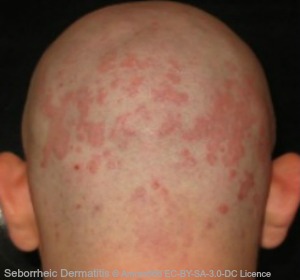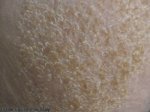Seborrhoeic Eczema
Can Start As Dandruff.
Treatment Stops It Spreading
Seborrhoeic Eczema, also spelt Seborrheic, is a condition that as a mild form, can be dandruff on the scalp. As a severe case you can have large patches that are red and flaky.
It normally appears after puberty. It can occur up to the age of 40.
Men are more likely to be affected.
Babies can get a similar condition on the scalp.

It is usually referred to as Cradle Cap.
It usually affects a baby in the first few months of their life.
If it appears elsewhere on a child's body it is called Infantile Seborrheic Dermatitis.
In adults it can appear on any part of the body.
It tends to be found on areas that produce a high amount of our skin's natural oils, Sebum.
Seborrhoea actually means 'flowing with sebum'.
Symptoms
Common areas affected by Seborrhoeic Eczema include
- Scalp
- Eyebrows
- Creases along the nose
- Forehead
- Eyelids
- Ears
- Back
- Armpits
- Groin
If you have a mild case, dandruff maybe the only symptom. It could make your scalp dry and slightly itchy. Some areas on the face may have some patches of flaky skin.
In a moderate case a rash will appear. It will look circular and inflamed. It could be itchy. Crusts may form on top of the rash.
A severe case is rarer. It can affect a large area. Looking very red and feeling very itchy.
Causes
It is thought to be caused by Pityrososporum ovale. This is a type of yeast that naturally lives on our skin. In most people it doesn’t cause any issues. On others the yeast can grow too much. This causes a reaction in the skin.
Some factors that are thought to promote the yeast growth are
- Stress
- Sweating
- Tiredness
- Climate (winter weather)
Eating foods that contain yeast are not thought to affect the condition. Although foods that have a high level of sugar are best avoided. As is excessive drinking of alcohol. Yeast feeds on sugar, so promoting it's growth, so affecting your seborrhoeic eczema.
Treatments
A majority of seborrhoeic eczema treatment can be done at home, and be brought without a prescription.
On the scalp the following can be done
- Daily washing of the scalp using shampoo
- 2-3 times a week using an anti-fungal shampoo to help treat the scalp
- Stopping using hair products that may aggravate the problem, like hairspray and mousse
On the days that an anti-fungal shampoo isn’t used, a normal shampoo can be used. It is an idea to use an anti-dandruff shampoo. You can use a supermarket brand or buy one over the counter at a chemist. Whichever one you choose make sure it doesn’t irritate your skin.
If the scalp is widely covered with thickened skin its a good idea to loosen it. One way is to apply some warm olive oil to the scalp just before bed. Leave it on overnight. In the morning wash the scalp using an anti-fungal shampoo.
When the rash is on other parts of the body there are some ways to tackle it
- Anti-fungal cream
- Topical steroid creams and ointments, to reduce inflammation and itching
- Getting a little bit of sun can help to improve the condition. Just a little sun though
As the suspected cause of this condition is excess yeast growth on the skin, it is likely to reoccur. It can happen when treatment is stopped. If it appears again, using the above treatments will help again.
If the outbreaks are often there are other treatments to consider. They may help to stop it reoccurring as often. Your doctor needs to provide them or refer you
- A prescription shampoo or cream, like ketoconazole
- UV light treatment
There are some suggestions that there are some foods that have anti-fungal properties. You could try adding some to your daily intake.
They have a high quality of either
- B Vitamins. Foods include brazil nuts and legumes
- Zinc. Foods include dried fruit and pumpkin seeds
- Omega 3 fatty acids. Foods include salmon and walnuts
Personal Story
I have had a mild case of seborrhoeic eczema on and off for the last few years.
I first noticed it as dandruff. At this point I didn’t know that dandruff was a form of eczema. I tried using a branded anti-dandruff shampoo. I didn’t see much of a difference. I just started to have a slightly itchy scalp as well.
Someone told me to use Polytar shampoo. I tried it a few times over a couple of weeks. Using a normal shampoo in-between. It worked a treat for me. The itchiness stopped and the dry flakes went.
The only downside I found with Polytar was that it smelt terrible. I could live with that a couple of times a week to have flake free hair. If the condition reoccurs I go back to using it.
It wont be the ideal treatment for everyone, but another preparation maybe. It is trial and error.
A couple of times when it has occurred I have noticed that I get dry skin running along my hairline. It goes onto the very front part of my scalp.
The best way for me to deal with it is just before I go to bed I put on some emollient. It goes along the hairline where the dry skin is. I do it at night as it goes in the front of my hair and makes it look a little greasy.
Return from Seborrhoeic Eczema to Types of Eczema
Return from Seborrhoeic Eczema to What is Eczema
Search What Is Eczema?
Advertising on What Is Eczema?
We are a participant in the Amazon Services LLC Associates Program, an affiliate program which allows sites to earn fees by advertising and linking to amazon.com. If you make a purchase through a link on this page, I may receive a small commission, at no extra cost to you. Many thanks
